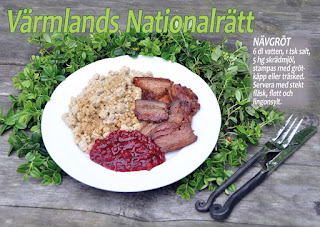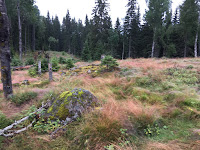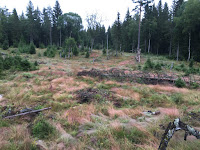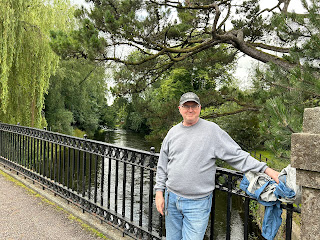With these words, the ghost of his father revealed to Hamlet that he had been murdered by his own brother, Hamlet's uncle. This certainly is not the normal type of story that one expects to come across in researching family history. Neither is the ghost of an ancestor the usual source of information on family history. Without recourse to ghosts, we have to rely on documents, images, DNA, or word-of-mouth. But sometimes these dry sources do reveal stories of long-forgotten crimes. Here are two such stories, both from the Barthelsson side of the family, incidents that took place in the mountains and forests of Värmland.
Henrik Olofsson Lehmoinen
This first story takes us back to the first Finnish settlers in the Värmland forests near the Norwegian border. I learned of the incident from the pages of the book Livet i Finnskogarna (Life in the Finnish Forests), a family history account written by Bjarne Persson. I must thank Ann Meyer Nordström for telling me about this little book. I also should be clear about what I ”know” and what I only think I know. The oldest digitized records that I've seen for this part of the family are for my 6th great grandfather, Bertil Henriksson Lehmoinen (1701-1788). Everything before Bertil is based on secondary sources, documents that I haven't yet been able to find and personally examine.
Bertil was the great grandson of the first Finnish settler in this part of Sweden, the nearly legendary Olof Mattsson (Koo) Lehmoinen. He's often seen in the records just as Olof Koo. Bjarne Persson records four sons of Olof: Klemet (born 1630), Pål (born 1633), Olof (born 1636), and the focus of this story, Henrik (1640).
(As a quick aside, my 6th great grandfather, Bertil, was not the son of this particular Henrik. Rather, his father seems to have been Henrik Olofsson, who was the son of Olof Olofsson, who in turn was the son of Olof Koo.)
The scene of the crime takes place in the forested hills of northern Värmland around the time of the St. Walpurgis celebration, that is, on or about 1 May, 1666 – yes, over 350 years ago! The neighbor Per Andersson visited the farmstead where Olof Koo and his sons lived in Skallbäcken. I posted images of our visit to Skallbäcken in my post But, Värmland... Per Andersson was another Forest Finn with the surname Kartikainen. It seems that he came to discuss or borrow some tools for plowing. Per and Henrik got to drinking, and a fight broke out. There must have been witnesses because calls for help went out. The two combatants wrestled and then the resorted to knives. Per scored first, hitting Henrik in the left arm, but it wasn't a serious wound. Henrik then stabbed Per in the stomach, and Per died two days later from the injury. The tragic part is that the two had been good friends before this altercation and, in fact, they reconciled afterwards in the short time that Per had left.
Afraid of the consequences of this deed, Henrik fled across the border into Norway. But he returned the next year and confessed to the crime. The case was heard during the seating of the Älvdal district court 18-19 November, 1667. During the hearing Henrik's father, Olof Koo, stood and pleaded for his son. He also presented a certificate from the victim's parents, Anders Persson and Anna Mårtonsdotter, stating that they did not seek Henrik's life. Additionally, Olof Koo had “compensated” the parents with a monetary sum of 40 Riksdaler and 20 “tunnor” of rye. (I've not yet been able to figure out either how much a Riksdaler was worth at the time, nor how much a “tunna” was.) Per's brother, Henrik Andersson, also seems to have been paid 4 1/3 Riksdaler. Despite pleas for mercy, the court sentenced Henrik to death for the murder of Per. At this point, things get a little confusing to me. Bjarne Persson records that Henrik may have subsequently been pardoned and escaped execution because there are records of his children born as late as 1678. Perhaps the money and grain sufficed after all!
I only discovered this story from Persson's book. His account of the murder seems to have been drawn from several sources, the most important being the district court record. Although he writes that his account comes from the “dombok,” he doesn't provide a specific citation. After digging through the digital archives, though, I finally found it! You can see it all in the image below.

Henrik's father appears in the court record: "Olof Koo i Skallebäcken" (Olof Koo from Skallebäcken).
There's a bit more information in the court record than in Persson's recounting, but I really can't say that I understand a whole lot from the record. I can find facts noted by Persson in the court record, but between the Gothic handwriting and 17th Century Swedish, I can only understand a little of what has been recorded. I can't really complain too much about the handwriting, it really is beautifully and carefully written. I just need more practice at reading it. The Swedish is probably a bit archaic as the meaning of words changes through time. It's probably comparable to the Shakespeare that you may have read in high school English class: Shakespeare's writing is clearly English, but not one that is easy for us to read today. And the timing is comparable: the quote from Hamlet that I began this post with was first published in 1603, a mere 63 years before this murder took place.
Per Mattsson
Per Mattsson was born on 08 December, 1836 to Matts Persson and Karin Hindriksdotter on a farm called Snipa, near Kristinefors. This is the same general area of my previous story: today it's only a 30 minute or so drive between Skallbäcken and Kristinefors. Per was baptized three days later in the Vitsand parish church. He was the third of seven children and the first boy born into the family. The family are also direct descendants of Olof Mattsson (Koo) Lehmoinen, making Per my 2nd cousin 4x removed. By the early 19th Century the days of slash-and-burn agriculture were long over. My understanding is that most residents made a living through traditional farming, forestry, or both. In the church records the father Matts is listed as a torpare, that is, a crofter or small tenant farmer.
In 1845, Per's father, Matts, died at the age of 35 of drowning. Following that, there is a 5-year gap in the records. In 1851 the family appears again in the church books. Somehow, the widow Karin managed to stay in the same area, possibly even the same plot of land in Snipa. In 1851 four of her children are living with her, Per being the eldest. The 1855-1860 household examination book records that he married Maria Jansdotter, and together they have a baby girl Carolina (b. 1860). I have not – yet – been able to find a record of the marriage between Per and Maria. The couple had a total of four children: Carolina, Maria (born 1863), Per Johan (born 1865) and Christina (born 1867).

Maria Jansdotter (1839-1922), wife of both Per and Matts Mattsson. Photo from ancestry.com site of user kayhill124.
This is where the story takes a tragic turn. A witness, Matts Mattsson (possibly Per's brother) reported that on the afternoon of Monday, July 12, 1869 Per, Sven Andersson, and Sven Persson had been drinking, apparently to excess. Around 9 that evening they headed home, with Per and Sven Persson riding in a cart, Matts and Sven Andersson walking. The two men in the cart got to arguing about who was going to drive, and the argument apparently continued during the trip. When they all got back to the farm around 11:30 that night Per Mattsson and Sven Persson went inside the house, out of sight of all other witnesses. Suddenly shouting and loud noises were heard, along with the cry ”You don't frighten me.” Afterwards Sven Persson staggered out, leaned for a while on the cart, and then went off to an empty cow barn. On going inside the house, witnesses found Per's on the floor, lying in a pool of his own blood. Upon later examination, the provincial doctor, Ludvig Kumlién, reported finding stab wound in the heart, and the left lung filled with blood.
These reports are taken from the district records of the case against Sven Persson. Ultimately Sven was convicted of murder and sentenced to six years imprisonment in the citadel in Malmö. The city of Malmö is in the far south of Sweden, just across the strait from Copenhagen. Sven was released in 1875, and returned to live and work in Vitsand until his death 1905.

The Malmö citadel where Sven Persson served his time for the murder of Per Mattsson. Today, this building serves as a museum.
While that was the end of Per Mattsson, the story continues. A little over two and a half years after Per's death, his widow, Maria Jansdotter remarried... to her brother-in-law Matts. The new couple had five children, Emma (b. 1871), Anna (b. 1874), Martin Vilhelm (b. 1877), Hulda Maria (b. 1879) and Ida Albertina (b. 1882). Matts died in 1882 in an accident. If I'm reading the record correctly it had something to do with floating logs, so possibly he was involved in harvesting timber and shipping it downriver. Widowed now for the second time at the age of 42, Maria continued to live in Kristinefors until 1896.
On 29 April, 1896 Maria Jansdotter and her daughter, Ida Albertina, left Sweden for North America. Maria's son, Martin Vilhelm, had earlier moved to Minnesota, using the name William Mattson. Maria is found in the 1910 census living in Rollis, a town in the northwestern corner of Minnesota. As an aside, her brother-in-law Henrik, younger brother of her husbands Pers and Matts, also emigrated to Minnesota. I've written about him earlier, see In the Midst of the Big Woods. The family subsequently moved from Rollis across the border to the Canadian province of Saskatchewan, settling about 40 miles due east of Saskatoon in Viscount and Meacham. So to my surprise and pleasure, it seems I (we) have quite a number of cousins living in western Canada.
Johanna Charlotta Barthelsson
This is not another story of murder, but one of discovery. Johanna Charlotta Barthelsson (1861-1922) was my great grandmother. Hans Malmkvist, cousin from Västerås, sent me some pictures he found a few months back while going through old letters, etc. in his family's summer home in Södermanland. Two of them are pictures of Lottie. One is a photo of her together with her daughter Wilma. Wilma was born in 1898, and Lottie died in 1922. You can make your own judgement about how old Wilma looks to be in the picture, but I'm guessing that the picture was taken sometime after 1915 and before 1922. The second picture shows Lottie with two children. The boy – to me anyway – looks just like my grandfather, Fred. (Compare this picture with his picture taken around 1917). If the baby is Wilma, then this picture probably was taken sometime between 1898 and 1900. Fred was born in 1888, so he would have been 10-12 years old.

Wilma Westerlund (on left) and her mother, Johanna Charlotta Barthelsson. Photo courtesy of Hans Malmkvist.

Johanna Charlotta Barthelson (on left) and her children, Arthur Westerlund (or Fred Johnson), and - I think - baby Wilma. Photo courtesy of Hans Malmkvist.
These pictures are fantastic, and many thanks to Hans for sharing them. But they're also frustrating in a way. Hans comes from the Westerlund side of the family. If you recall earlier posts, his great grandfather (Gottfrid Theodor) and my great grandfather (Gustaf Alfred) were brothers, so that makes us 3rd cousins. The frustrating part is that my great grandfather appears in none of these pictures! I still don't have any idea of what he looked like. And as I think about it, I wonder if it wasn't Alfred behind the camera all the time? Maybe he was one of the early adopters of cameras.
One last thing...
The year 2017 is the centennial of the U.S. entering the first World War. In commemoration, the Herkimer County Historical Society put out a call for pictures of local veterans from WWI, preferably in uniform. The plan was to create an exhibit in the Society's building, and also to have banners made that would be hung along the streets in the veterans' home towns. I contributed the image of my grandfather, Fredrik A. Johnson (thanks to Ron Johnson for sending me a copy of that picture in the first place). Nephew Keith Johnson first spied the banner with Fred's picture on Central Avenue (Route 51). The banners were only to be on display until the end of August, so we made a quick trip “back home” just to see it in person. Below is a picture of me posing with my grandfather.
Thanks to all who contributed in any way to this blog post, to Ann Meyer Nordström, Hans Malmkvist, Bjarne Persson (with whom I've never met nor corresponded), Ron Johnson, Keith Johnson, and Luciana Musetti.



















































